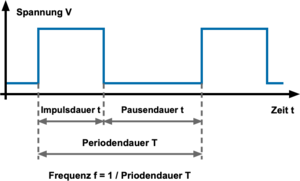PWM
PWM (abbreviation for pulse width modulation) is a type of digital modulation in which a technical variable (e.g. an electrical voltage) alternates between two values. A rectangular pulse is generated (modulated) at a constant frequency, the width and length of which varies. The ratio between pulse and period duration (sum of pulse and pause duration) is referred to as duty cycle.
 (Source: www.elektronik-kompendium.de)
(Source: www.elektronik-kompendium.de)
A PWM signal must be generated by a PWM generator. For this purpose, a frequency is set (reciprocal of the period duration) and the duty cycle is specified, which corresponds to the duration of the pulse within the period duration.
Pulse width modulation, or PWM for short, is also known as pulse width modulation (PBM), pulse duration modulation (PDM), pulse length modulation (PLM) or the undershoot method.
English: pulse width modulation (PWM), pulse time modulation (PTM) or pulse duration modulation (PDM).
A PWM signal is suitable …
– as a control signal in control and regulation technology.
– as a measurement signal.
– for the transmission of data.
– for driving a load with variable voltage by the average value of the voltage, which can be varied by changing the pulse width.
PWM signal as control signal
There are applications in the field of control and regulation where a separate PWM signal is used to transmit information for control or regulation. The information is then contained in the duty cycle of the PWM signal.
Examples of this are
– Servo motor position control: PWM signals can be used to set the position (angle) of a servo motor.
– Fan speed control: A PWM signal can be used to control the speed of fans.
– Controlling the power of AC drives: PWM signals can be used to control the power of AC drives such as inverters or frequency converters.
PWM signal as measuring signal
A PWM signal generator can be used to generate any rectangular signal. Within a measurement application, for example, you can measure the time it takes to receive a certain number of pulses of a specific PWM signal.
